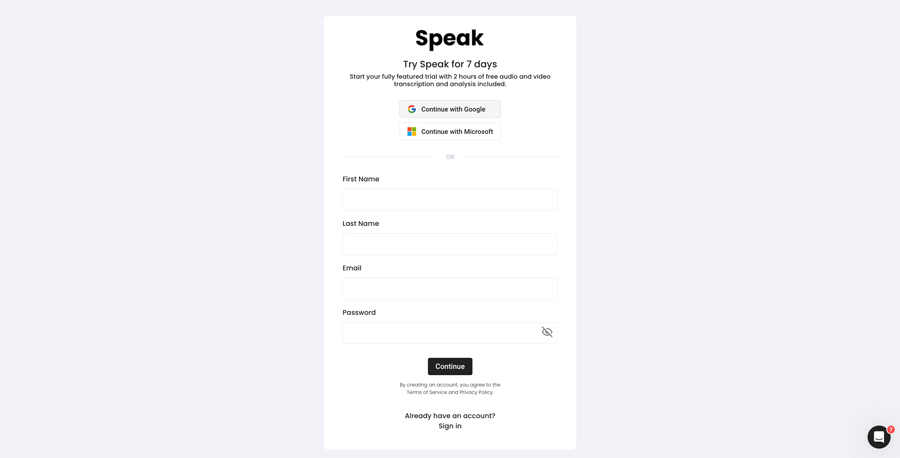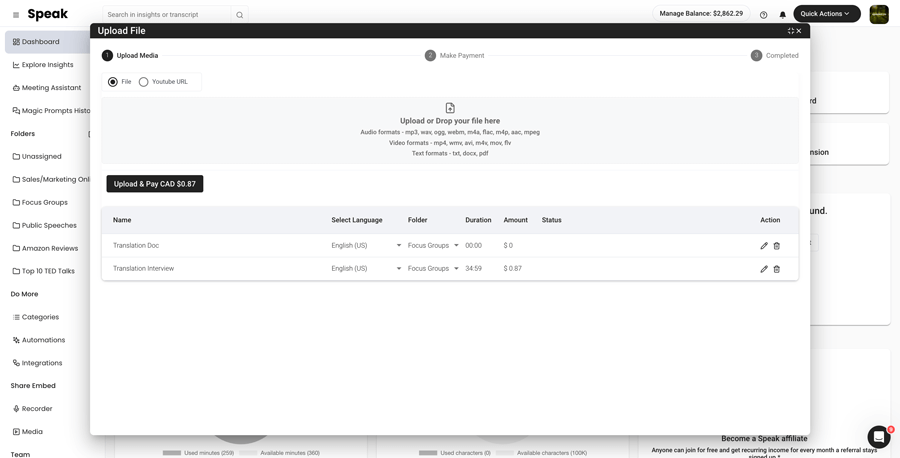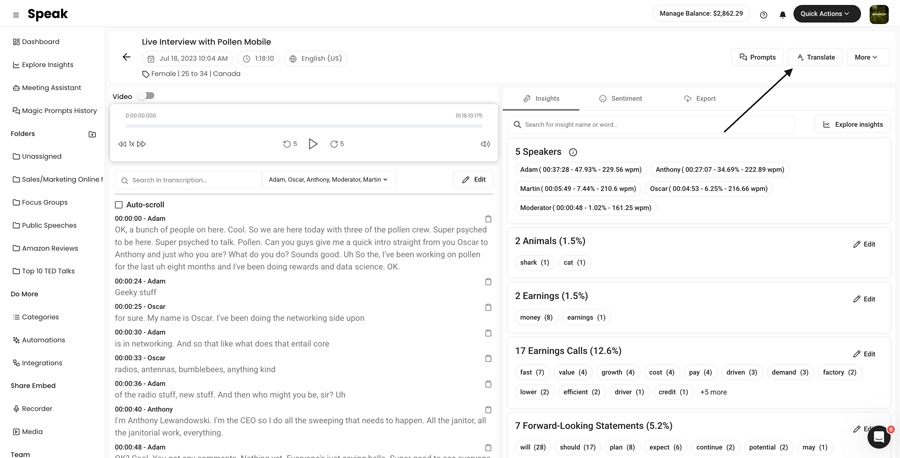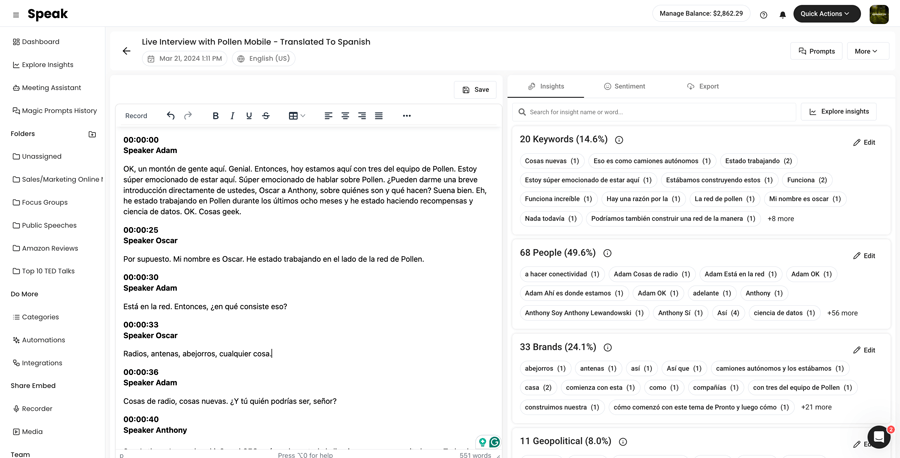How To Translate Chinese (Simplified) to Portuguese
Translating Chinese (Simplified) to Portuguese is super simple!

Step 1: Register for Speak
Register for Speak using this link.
Once you register, you can instantly begin translating your Chinese (Simplified) to Portuguese file(s).

Step 2: Upload Your Chinese (Simplified) file(s)
As soon as you log in, you will be redirected to the dashboard.
Once there, you can select the Quick Action “New Upload”.
In Speak, you can seamlessly upload, transcribe and translate audio, video and text files all at once!

Step 3: Translate Your Chinese (Simplified) file(s) to Portuguese
Once the file is uploaded, simply visit your file and select “Translate”.
If it is an audio and video file, Speak will ask you if you want to keep the speaker names and timestamps in the translation.
Want to translate many files at once? No problem!
You can view the files you want to automatically translate from Chinese (Simplified) to Portuguese from the folder level and instantly translate as many files as you need with our artificial intelligence translation in just a few clicks.

Step 4: That’s It! View, Analyze, Modify & Export Your New Portuguese file(s)
Once the translation is done, you will be alerted and you will see a new document in the same folder your original file is in.
The file will be named the same but with a dash indicating that it is the translated version.
Need support with your Chinese (Simplified) translation?
We are always here and happy to help at Speak!
Just send us a message on live chat on the bottom right corner and we will ensure you are set up for success.
Interested in translating Chinese (Simplified) or other languages to different languages? View our entire list of supported translation languages here.
Automatic, accurate, instant AI translation from Chinese (Simplified) to Portuguese is here for you.
Register for Speak using this link and begin translating Chinese (Simplified) to Portuguese today.
Unveiling the Power of AI in Translating Chinese (Simplified) to Portuguese
In the fast-paced global market, the ability to communicate across languages is more than a convenience—it’s a necessity. With Chinese (Simplified) and Portuguese being key languages in international business, education, and technology, unlocking efficient pathways for translation is paramount. Speak AI introduces an innovative solution through automatic translation, leveraging advanced NLP, large language models, and AI to bridge the gap between these languages seamlessly.
The Revolutionary Impact of AI Translation
AI-powered translation services are transforming how we understand and engage with different cultures and languages. By combining the precision of human-like understanding with the efficiency of machine processing, Speak AI’s translation technology ensures that the essence of every conversation and document is preserved and accurately conveyed.
Benefits of Chinese (Simplified) to Portuguese Translation
- Expanding Global Reach: Businesses and researchers can tap into new markets and collaborations without language barriers.
- Enhanced Learning Resources: Educational materials can be accessed by a wider audience in their native or preferred language.
- Cultural Preservation: AI translation helps in keeping cultural nuances intact, promoting deeper understanding and appreciation.
Saving Time and Costs
Automatic translation significantly reduces the time and expenses associated with traditional translation methods. Speak AI’s efficient processing allows for real-time translation of audio, video, and text, eliminating the need for manual transcription and translation.
Introducing Speak AI: Your Companion for Seamless Translation
With a stellar 4.9 rating on G2 and over 150,000 users, Speak AI stands at the forefront of translation technology. Our AI Meeting Assistant effortlessly joins meetings on Microsoft Teams, Zoom, Google Meet, and Webex, providing instant transcriptions and analyses. This level of integration makes automatic analysis and translation not just possible but remarkably accurate.
Use Cases in Research and Business
- Market Research: Instantly translate interviews and focus groups to gather insights across language barriers.
- Customer Support: Offer multilingual support by translating customer queries and responses in real-time.
- Content Localization: Adapt your digital content for different regions without losing the original message’s impact.
Understanding the Landscape: Chinese (Simplified) and Portuguese Globally
Where These Languages Thrive
Chinese (Simplified) is predominantly used in mainland China, Singapore, and among the Chinese diaspora worldwide. Portuguese, on the other hand, is the official language of Portugal, Brazil, and several African countries such as Mozambique and Angola, reflecting its rich history of exploration and colonization.
Statistical Insights
With over 1 billion native Chinese (Simplified) speakers and approximately 260 million Portuguese speakers globally, the economic, cultural, and technological exchanges between these languages are vast and dynamic.
Diving into Cultural Richness
Interesting Facts
- Chinese (Simplified) uses characters, each representing a word or concept, while Portuguese is a Latin-based alphabetic language.
- Portugal holds the record for the longest-standing alliance with England, which has profoundly influenced language evolution.
Analyzing Linguistic Nuances
Differences and Similarities
The structure of Chinese (Simplified) and Portuguese differs significantly, with Chinese being a tonal language and Portuguese using stress and inflection to convey meaning. However, both languages share a focus on context and cultural nuances, making accurate translation a delicate art that AI is uniquely positioned to handle.
Embracing the Future of Translation with Speak AI
As we advance into an increasingly globalized world, the need for efficient, accurate translation grows. Speak AI’s commitment to innovation in AI translation technology promises to keep you ahead, ensuring that no language barrier can hinder your ambitions. Whether it’s for business expansion, research, or personal growth, translating Chinese (Simplified) to Portuguese has never been more accessible or more accurate. Join the ranks of satisfied users and experience the future of translation today.
Call to Action
Ready to transcend language barriers and unlock new possibilities? Sign up for Speak AI and revolutionize how you communicate, understand, and connect across languages. Your global journey begins here.
—
### Answering Your Questions:
– **Locations where Chinese (Simplified) and Portuguese are popular:**
– Chinese (Simplified) is primarily spoken in Mainland China and Singapore. It serves as an essential bridge for communication with the vast Chinese-speaking population worldwide.
– Portuguese is predominantly spoken in Brazil and Portugal, with significant speakers in Mozambique, Angola, and other parts of Africa and Asia, reflecting its colonial history.
– **Interesting stats:**
– Chinese (Simplified) boasts over 1 billion speakers, making it one of the most spoken languages worldwide.
– Portuguese has approximately 260 million speakers, making it the 6th most spoken language globally, with Brazil being the largest Portuguese-speaking country.
– **Fun Facts:**
– Chinese characters, unlike alphabetic scripts, can express complex ideas with a single symbol.
– Portugal and England have the world’s oldest operating military alliance, established in the 14th century, influencing cultural and linguistic exchanges.
– **Differences and Similarities between Chinese (Simplified) and Portuguese:**
– *Differences*: Chinese (Simplified) relies on tone to differentiate meaning, while Portuguese uses stress and inflection. Chinese uses characters, and Portuguese uses the Latin alphabet.
– *Similarities*: Both languages value context and cultural nuances, making translation that respects these elements crucial for accurate communication.
Translate Chinese (Simplified) To These Other Supported Languages:
- Translate Chinese (Simplified)-to-Albanian
- Translate Chinese (Simplified)-to-Amharic
- Translate Chinese (Simplified)-to-Arabic (Egypt)
- Translate Chinese (Simplified)-to-Arabic (Iraq)
- Translate Chinese (Simplified)-to-Arabic (Israel)
- Translate Chinese (Simplified)-to-Arabic (Jordan)
- Translate Chinese (Simplified)-to-Arabic (Kuwait)
- Translate Chinese (Simplified)-to-Arabic (Lebanon)
- Translate Chinese (Simplified)-to-Arabic (Oman)
- Translate Chinese (Simplified)-to-Arabic (Palestinian Authority)
- Translate Chinese (Simplified)-to-Arabic (Qatar)
- Translate Chinese (Simplified)-to-Arabic (Saudi Arabia)
- Translate Chinese (Simplified)-to-Arabic (Syrian Arab Republic)
- Translate Chinese (Simplified)-to-Arabic (United Arab Emirates)
- Translate Chinese (Simplified)-to-Arabic Modern Standard (Bahrain)
- Translate Chinese (Simplified)-to-Armenian
- Translate Chinese (Simplified)-to-Azerbaijani
- Translate Chinese (Simplified)-to-Bengali
- Translate Chinese (Simplified)-to-Bosnian
- Translate Chinese (Simplified)-to-Bulgarian
- Translate Chinese (Simplified)-to-Catalan
- Translate Chinese (Simplified)-to-Chinese (Cantonese, Traditional)
- Translate Chinese (Simplified)-to-Chinese (Simplified)
- Translate Chinese (Simplified)-to-Chinese (Traditional)
- Translate Chinese (Simplified)-to-Croatian
- Translate Chinese (Simplified)-to-Czech
- Translate Chinese (Simplified)-to-Danish
- Translate Chinese (Simplified)-to-Dari
- Translate Chinese (Simplified)-to-Dutch
- Translate Chinese (Simplified)-to-English
- Translate Chinese (Simplified)-to-English (Australia)
- Translate Chinese (Simplified)-to-English (India)
- Translate Chinese (Simplified)-to-English (Ireland)
- Translate Chinese (Simplified)-to-English (New Zealand)
- Translate Chinese (Simplified)-to-English (Scottish)
- Translate Chinese (Simplified)-to-English (South African)
- Translate Chinese (Simplified)-to-English (United Kingdom)
- Translate Chinese (Simplified)-to-English (United States)
- Translate Chinese (Simplified)-to-Estonian
- Translate Chinese (Simplified)-to-Farsi (Persian)
- Translate Chinese (Simplified)-to-Finnish
- Translate Chinese (Simplified)-to-French
- Translate Chinese (Simplified)-to-French (Canada)
- Translate Chinese (Simplified)-to-Georgian
- Translate Chinese (Simplified)-to-German
- Translate Chinese (Simplified)-to-German (Swiss)
- Translate Chinese (Simplified)-to-Greek
- Translate Chinese (Simplified)-to-Gujarati
- Translate Chinese (Simplified)-to-Haitian Creole
- Translate Chinese (Simplified)-to-Hausa
- Translate Chinese (Simplified)-to-Hebrew
- Translate Chinese (Simplified)-to-Hindi
- Translate Chinese (Simplified)-to-Hungarian
- Translate Chinese (Simplified)-to-Icelandic
- Translate Chinese (Simplified)-to-Indonesian
- Translate Chinese (Simplified)-to-Irish
- Translate Chinese (Simplified)-to-Italian
- Translate Chinese (Simplified)-to-Japanese
- Translate Chinese (Simplified)-to-Kannada
- Translate Chinese (Simplified)-to-Kazakh
- Translate Chinese (Simplified)-to-Korean
- Translate Chinese (Simplified)-to-Latvian
- Translate Chinese (Simplified)-to-Lithuanian
- Translate Chinese (Simplified)-to-Macedonian
- Translate Chinese (Simplified)-to-Malay
- Translate Chinese (Simplified)-to-Malayalam
- Translate Chinese (Simplified)-to-Maltese
- Translate Chinese (Simplified)-to-Marathi
- Translate Chinese (Simplified)-to-Mongolian
- Translate Chinese (Simplified)-to-Norwegian
- Translate Chinese (Simplified)-to-Pashto
- Translate Chinese (Simplified)-to-Persian
- Translate Chinese (Simplified)-to-Polish
- Translate Chinese (Simplified)-to-Portuguese
- Translate Chinese (Simplified)-to-Portuguese (Brazilian)
- Translate Chinese (Simplified)-to-Portuguese (Portugal)
- Translate Chinese (Simplified)-to-Punjabi
- Translate Chinese (Simplified)-to-Romanian
- Translate Chinese (Simplified)-to-Russian
- Translate Chinese (Simplified)-to-Serbian
- Translate Chinese (Simplified)-to-Sinhala
- Translate Chinese (Simplified)-to-Slovak
- Translate Chinese (Simplified)-to-Slovenian
- Translate Chinese (Simplified)-to-Somali
- Translate Chinese (Simplified)-to-Spanish
- Translate Chinese (Simplified)-to-Spanish (Mexico)
- Translate Chinese (Simplified)-to-Swahili
- Translate Chinese (Simplified)-to-Swedish
- Translate Chinese (Simplified)-to-Tamil
- Translate Chinese (Simplified)-to-Telugu
- Translate Chinese (Simplified)-to-Thai
- Translate Chinese (Simplified)-to-Turkish
- Translate Chinese (Simplified)-to-Ukrainian
- Translate Chinese (Simplified)-to-Urdu
- Translate Chinese (Simplified)-to-Uzbek
- Translate Chinese (Simplified)-to-Vietnamese
- Translate Chinese (Simplified)-to-Welsh



